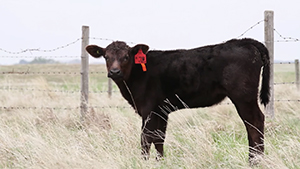Nature vs. Nurture

This article written by Dr. Reynold Bergen, BCRC Science Director, originally appeared in the December 2019 issue of Canadian Cattlemen magazine and is reprinted on the BCRC Blog with permission of the publisher.
Nothing is ever as simple as we think it is or wish it was.
We’ve known for centuries that an animal’s performance, health, behavior and other traits depend on a combination of their genetics and their environment. The genetics are inherited from their parents. Environmental influences are not inherited. Environments might be similar across generations but they’re rarely identical. Even on the same operation, older cows may have spent their early winters eating stored forage in corrals or barns, while younger cows may have been wintered on swaths with less shelter. Weather, growing conditions, nutritional quality of pasture, harvested feeds and supplements and many other factors also vary from year to year, so offspring don’t inherit their parent’s environment.
But it might not be that simple. Researchers are finding evidence that the environment can physically impact genes in ways that can be passed to second, third or even later generations. This is one example of a larger phenomenon called epigenetics. A 2002 study that looked at diet, diabetes and cardiovascular (heart) disease in northern Sweden over 105 years (doi:10.1038/sj.ejhg.5200859) found that when men were raised during periods of famine (due to war or crop failures), their offspring and grandchildren were more likely to die of heart disease. When crops were good, armies weren’t marauding and food was abundant, their grandchildren were more likely to develop diabetes.
No one knows exactly how epigenetics works, but it appears that nutritional (or even emotional) challenges can cause small molecules (methyl groups are one example) to bind to genes or regulatory sequences in DNA (this is called methylation). Methylation can alter gene expression. If you think of a regulatory gene as a light switch and a methyl group as a piece of duct-tape, then a methylated gene would be a switch that has been duct-taped in the on (or off) position. The design of the electrical circuit hasn’t changed, but its functionality has. If the methylated gene is passed on to offspring, it will remain stuck in the on (or off) position in subsequent generation(s), even though the gene itself hasn’t changed. The tape gradually loses its stickiness and falls off, reversing the methylation and returning the gene to its normal function.
Epigenetics is being studied in beef cattle. A Beef Science Cluster study led by Katie Wood (University of Guelph) and Carolyn Fitzsimmons (University of Alberta) showed that changing feed intake levels during pregnancy can cause epigenetic changes in the fetal calf (DOI: 10.1186/s12864-017-4051-5).
What They Did:
Starting at 5 months of gestation, pregnant beef cows were fed as much as they wanted (HIGH diet) or had their intake slightly restricted for 100 days (LOW diet). As part of a larger study, 11 cows per group were slaughtered a month before calving. The fetus and placenta were collected, and methylation and gene expression were measured in several fetal genes and tissues. A gene coding for insulin-like growth factor 2 (IGF2) was studied in detail. IGF2 promotes cellular growth and proliferation in many different tissues before birth.
What They Learned:
All cows averaged 1,410 lbs at the start of the trial, but the restricted cows weighed 140 lbs less at the end (1,652 vs. 1,513 lbs). Both groups of fetuses weighed the same (66 lbs), with no differences in placental or fetal organ weights.
The IGF2 gene was much more methylated in fetuses from cows fed the HIGH diet than cows fed the LOW diet. Methylation reduced the expression of the IGF2 gene in some (but not all) tissues. IGF2 gene expression in the caruncle (cow side) and the cotyledon (calf side) of the placenta was the same in both HIGH and LOW cows. This may explain why there were no differences in total fetal weight or fetal development. IGF2 expression was same in the heart and liver of fetuses from both the HIGH and LOW cows, but IGF2 expression were reduced in the eye of round of HIGH fetuses. IGF2 expression also tended to be lower in the ribeye of HIGH fetuses.
What it Means:
This was a relatively mild nutritional challenge, but it was enough to induce epigenetic changes in the calves. None of these cows were anywhere close to starving; the LOW cows just gained less weight. That suggests this phenomenon is probably going on all the time in commercial herds. Methylation is often thought to be a response to an environmental insult, so it’s interesting that the increased gene methylation and reduced gene expression were most apparent in the cows that ate as much as they wanted, not the cows whose intake was restricted. But cattle have millions of genes, and methylation may have different impacts on other genes that weren’t examined in this study.
More research is needed to know whether epigenetic differences related to cow feeding practices affect the health, growth, reproductive performance or meat quality of their calves in any significant way, whether this gene methylation would pass to the next generation or beyond, or whether specific management tweaks can induce (or avoid) beneficial (or undesirable) epigenetic effects in calves.
The Beef Research Cluster is funded by the Canadian Beef Cattle Check-Off and Agriculture and Agri-Food Canada with additional contributions from provincial beef industry groups and governments to advance research and technology transfer supporting the Canadian beef industry’s vision to be recognized as a preferred supplier of healthy, high quality beef, cattle and genetics.
Click here to subscribe to the BCRC Blog and receive email notifications when new content is posted.
The sharing or reprinting of BCRC Blog articles is typically welcome and encouraged, however this article requires permission of the original publisher.
We welcome your questions, comments and suggestions. Contact us directly or generate public discussion by posting your thoughts below.